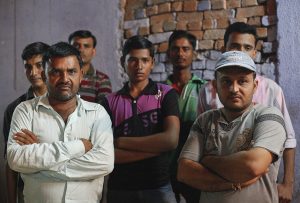Goa is abuzz with excitement as vintage bike and car owners, users, collectors and fans are decking […]

TOO MANY MEN IN INDIA & CHINA!
Perspective, Sept 08- Sept 14 2018 September 8, 2018The very vivacious India Bureau Chief of The Washington Post, Annie Gowen, was in Goa recently to deliver a talk at the International Centre Goa. The subject matter of her talk was how an imbalance in male-female gender ratio, or too few women for too many men in India and China…is impacting society. Changing lifestyle attitudes and behavioural patterns are leading to despair, loneliness and oftentimes violence manifests itself at ground level. We carry the entire talk she delivered at the ICG on Aug 6, 2018, in this issue of the `Goan Observer’ because it is thought-provoking and concerns us all…
By Annie Gowen
Gender imbalance in India and China is a pressing issue. Nothing like this has happened in human history. A combination of cultural preferences, government decree and modern medical technology in the world’s two largest countries has created a gender imbalance on a continental scale. Men outnumber women by 70 million in China and India.
The consequences of having too many men, now coming of age, are far-reaching: Beyond an epidemic of loneliness, the imbalance distorts labour markets, drives up savings rates in China and drives down consumption, artificially inflates certain property values, and parallels increases in violent crime, trafficking or prostitution in a growing number of locations.
Barely recognized, the ramifications of too many men are only starting to come into sight.
Out of China’s population of 1.4 billion, there are nearly 34 million more males than females — the equivalent of almost the entire population of California, or Poland, who will never find wives and only rarely have sex. China’s official one-child policy, in effect from 1979 to 2015, was a huge factor in creating this imbalance, as millions of couples were determined that their child should be a son.
India, a country that has a deeply held preference for sons and male heirs, has an excess of 37 million males, according to its most recent census. The number of newborn female babies compared with males has continued to plummet, even as the country grows more developed and prosperous. The imbalance creates a surplus of bachelors and exacerbates human trafficking, both for brides and, possibly, prostitution. Officials attribute this to the advent of sex-selective technology in the last 30 years, which is now banned but still in widespread practice.
In the two countries, 50 million excess males are under age 20.
Both nations are belatedly trying to come to grips with the policies that created this male-heavy generation. And demographers say it will take decades for the ramifications of the bulge to fade away.
GENESIS
But first, a bit about how our work in this area came about. In 2016, I was casting around for a project for the coming year and attended the book launch of sociologist Ravinder Kaur’s excellent book on this topic called ‘Too Many Men, Too Few Women,” a collection of essays on the social consequences of Gender imbalance on India and China which I recommend if you haven’t read it already.
Kaur’s point in the book was that while much has been written about the problem of gender imbalance at the infant level — i.e. why and how female foeticide occurs in India and China — little has yet been explored about the consequences. In other words — how is this playing out on the ground now? There’s a lot of research and publicity surrounding the so-called bride shortage in China and Northern India for example, but little that’s definitive date about the linkage between the gender imbalance and rising crime rates, particularly crimes against women here in India.
So we decided to embark on a joint project with the India and China bureaus to explore the topic in 2017. In this, I partnered with Simon Denyer, who was then the Beijing bureau chief and is an excellent reporter and friend who also knows India. He had the India bureau chief job before me and also spent six years as the Reuters bureau chief in Delhi before that.
So we spent several months in 2017 researching the phenomenon, which resulted in four magazine length articles that were to run as a series in October — two by me, two by Simon. Literally the night before the stories were set to run in the newspaper our managing editor decided that the four article format didn’t work and he wanted to try something else — preferably. Simon and I were furious! How dare they cut our golden prose and smush it into one story! Then the story was turned over to the graphics department which took several more months to build the amazing graphic story that finally ran online and in the newspaper this April.
I hate to say it — but my boss was right.
The story got a tremendous response online — with a combined 3 million readers around the world, with 42,000 social media shares. We were thrilled with the response — but I think it shows that there is an intense interest in global gender issues, and this man-made demographic bubble is one of its most pressing problems.
So as referred to in the introduction, both China and India have been grappling with this problem brought on by a centuries of son-preference but the problem has been exacerbated by artificial forces that came to pass in the 1980s — the instigation of China’s “One Child” policy, which hastened the rate of female feticide there — and the advent of sex selection technology that made ultrasound and abortion clinics widespread in Indian villages — even today.
I’d like to talk roughly about four areas where this gender imbalance is impacting society.
MARRIAGE SQUEEZE
But first, what is the so-called “marriage squeeze” — that’s the term demographers are giving to this surplus of bachelors who will be having difficulty finding wives in the decades to come.
The numbers are staggering. The French demographer and sociologist Christophe Guilmoto estimates that the number of men who will stay single in China would be 32 million from 2020 and 2080, and the number of surplus men in India to be 40 million, because the Indian populations of cohort is larger.
So this marriage squeeze is already having wide ranging impact in both countries.
IMPACT ON THE ECONOMY
The first phenomenon is an interesting phenomenon playing out in China, where some researchers believe that the shortage of brides is actually having an impact on the economy. Families have to sock so much savings away to attract brides some experts fear the country’s savings rate is growing too high.
In China, families pay a “bride price” that is similar to dowry but is paid from the groom’s family to the bride’s parents — the reverse of how it happens in rest of the world. In China, the bride price is skyrocketing.
But remember those stories about “bachelor villages” in China a few years back? Of villages empty of women? Actually most villages are empty these days, because the men have also migrated for work — and are trying desperately to make money to afford to build a house to attract a woman.
We met a young bachelor named Li Defu who said he reckoned he would have to pay $10K for a bride. A decade or two back, the typical bride price was just a few hundred dollars. Today, in some parts of China, the average is nearly $30,000, according to a survey by the People’s Daily newspaper.
Li Defu is typical. Now 21, he left home seven years ago to find work in the provincial capital Guiyang, but he has pooled the family savings to build a 10-room house overlooking the green hills and valleys of his birthplace, Paifeng.
The reason is simple: It is the only chance he has of finding a wife.
“At the moment, there aren’t any girls my age around,” he said told us. “But I am building this new house in preparation, in case I find someone.”
In India, the discussion of dowry is a lot more complicated. Some sociologists believe that dowry has become generally more widespread and that the groom’s families expectations for cars and other ostentatious displays of wealth have worsened. But other sociologists believe that ultimately brides may be able to negotiate less dowry or no dowry at all as the marriage market worsened. Conversely, the fact that bride’s families won’t have to save so much for dowry could have a negative impact on the country’s savings rate over time.
BUYING BRIDES
So with such a widespread shortage of women already being felt in places in China and northern India, it’s not surprising that families have begun actually buying brides through marriage brokers — some who don’t have the best interests of the women at heart.
So in China, Simon profiled a man in southeastern China who “bought” a wife for about $15,000 from Cambodia. The couple seemed happy and had two children. But she was bitter because a job she had promised never materialized.
“Our village has 50 or 60 bachelors and only one or two single women,” the husband told us. “For men who are 40 or even older, Cambodian women are like a second chance.”
Chinese men are not only looking to Cambodia but Vietnam and Russia too. Commercial marriage tours to Russia as well as Ukraine offer Chinese men the chance to meet 10 or 20 women over the space of a few days for around $5,000, rising to $8,000 if they find a bride.
In India, we spent several days in Haryana villages meeting women who had come from the Northeast to marry a Haryana man. Most of them were from desperately poor families, so although it’s likely some money changed hands, it wasn’t much. Their parents were just relieved to get them married without having to pay dowry. Some were happy, some described having drunken, loutish husbands who beat them. Sociologists say that these imported women — often from a different caste or speaking a different language — often have difficulty adjusting and are not treated with the same respect as local women.
Of course, the dark side of all this moves beyond bride price to actual human trafficking, which is a growing problem as well in China as well as India, where women are trafficked in from Nepal and Bangladesh.
In Cambodia, Simon met a woman who was trafficked to marry a man in China, bore him a child, only to return home because she couldn’t tolerate the abuse. The only catch was — she was forced to leave her daughter behind. So a very sad story.
MENTAL HEALTH
All this has a huge impact on village life and mental health. Loneliness and depression are widespread. Villages emptying out. Men learning to cook and performing chores long relegated to women.
One of the biggest problems China is facing is its growing population of elderly bachelors, who face depression and isolation, particularly in impoverished rural areas. Some scholars have argued that these bachelors could one day contribute to social unrest, particularly those that reside in areas with heavy ethnic minority populations.
In India, too, we saw the depression and sadness of bachelors. We spent a long time in an area called Bass in Haryana and met this one bachelor who spoke movingly of his experience.
Suresh Kumar once dreamed of getting married, with a procession through the lanes of Bass, a bride adorned in gold and the kind of ceremony that was once a near-universal rite of passage for Indian men.
But after one potential engagement fell apart, no other suitable brides could be found. He even went back to earn his high school degree in hopes of being a more attractive suitor.
Still no one. Now Kumar is in his mid-30s, long past what is considered marriageable age in India, and is beginning to face a hard truth — that a wife and a family won’t happen for him.
“People say, ‘You don’t have a wife and children at home to care for — why are you working so hard?’ ” Kumar said. “I laugh on the outside, but the pain that I have in my heart only I know.”
The men themselves are isolated, left out of major family decisions and subject to ridicule, with little in the way of support or mental-health services. Worse, in the traditional culture of villages, those who missed out on marriage have no hope of female companionship — dating or having a girlfriend is out of the question.
One recent evening, a family threw a rooftop party to celebrate the birth of a boy. Parties to welcome girl babies are still so rare they are covered by the local newspaper. Before the guests arrived, Kumar huddled in a stairwell nearby, sweating over a cast-iron pot, cracking jokes with friends as he fried sweet pancakes for the guests.
He likes to cook, he says, but the role occasionally unbalances him.
During a harvest festival last year, his mother was delayed in another town. So Kumar was left to prepare the pancakes on his own. As he flipped the cakes in the bubbling oil, he grew teary-eyed, thinking of how there were no wife and kids to eat the treats he was making.
With a wife, he says, “there would be somebody to make tea for me, to tell me when to take a bath. We don’t have much value as unmarried men in this society. Everybody thinks, ‘What problem does this man have? What is lacking in his family? What is lacking in him?’ ”
Evenings are the loneliest times, when the village folds into itself, minders return with their cows from the pond, smoke wafts from evening meals, schoolchildren still in their plaid uniforms play in the uneven lanes. Kumar shuts himself in his room.
“I watch TV, romantic movies sometimes,” Kumar says. “What can I do? It’s up to me then. What I feel inside stays inside.”
It wasn’t supposed to end up this way. When he was in high school, he had a brief romance with a classmate, a beautiful 17-year-old, tall and slim, with two braids that reached down her back. Even now he cannot speak of her without singing a few bars of an Urdu love song. “I looked for her on Facebook just yesterday,” he says.
But the tryst was discovered, the parents put a stop to it, and his classmate eventually married someone else. And the family wasn’t able to find any other suitable prospective brides for him.
“We feel it, but this is a problem in every house,” said his mother, Bhima, sitting with her son after the party in the dimly lit courtyard of the modest house where they live.
Sometimes, Kumar says, the suffocation he feels is palpable:
“You know how when there’s no wind and a plant is sitting there and the leaves are not moving? That’s how the man feels: You’re just stationary.”
Public safety
With the increase in men has come a surge in sexual crime in India and concerns about a rise in other crimes in both countries.
In China, for example, one 2007 study showed that male sex ratios may have contributed to one-sixth of the rise of overall crime. And that’s just going to get worse.
But data-wise, the studies linking the rising crime rates in India have been all over the map. And one recent study by Ravinder Kaur and her husband Surjit Bhalla for the United Nations Population Fund about sex ratio and crime in northern Indian couldn’t establish the link.
Harassment of schoolgirls in India has in some towns sparked an effort to push back — but at a cost of restricting them to more protected lives.
But there was a study in 2014 for the National Institutes of Health by Scott South, a professor of

ACCELERATING PROBLEM: A called the village of eternal bachelors was recently in the news. 70% of the men there are unmarried with over 350 unmarried men over 35 alone!
the University of Albany, that showed that in places in northern India where there was an unbalanced sex ratio women were most likely to be harrassed and targetted for some pass-time fun.
We met young girls in a village in Haryana who rose up on strike because they didn’t want to walk to a secondary school a mile and a half a way because they were constantly harassed on the road by boys buzzing them and grabbing at them on motorcycles. Eventually the state school board relented and agreed to add teachers to have high school classes in their existing school.
But such victories are rare.
So what’s to be done?
In India, sociologists argue that there needs to be far more public awareness around the issue, and the government has taken some steps towards that.
Prime Minister Modi spoke out about the need to protect girls in a ground-breaking moment in speech at the Red Fort on Independence Day and later launched the Beti Bachao, Beti Padhao (save the girl child, educate the girl child) campaign. Haryana officials say they’re making strides in reducing their child-sex ratio since that time, but more data is needed to assess that assertion.
Better enforcement is needed of India’s ban on sex-selective diagnostic testing, in place since 2004, with a strengthening of the law in 2003. Low enforcement — one 2009 study showed only 606 arrests and none at all in 22 of the states — as also low consequences, three years imprisonment and a `10,000 fine, are a problem
Attitudes are so ingrained, it’s overwhelming for advocates and workers.
Many families in the area still believe it is better to abort their unborn girls because it will hard to protect them from sexual violence later in life, and parents will have to pay pricey dowry when the girls are married.
“There is pressure here. Instead of having a girl, raising her and having something like a rape happen to her, we should just clean it out” of the womb, said Shashi Kant, a mother of two children, a boy and a girl, who hails from a neighbouring village. “Most of women in the village think that way. I also think that way.”
China on the other hand has been systematically trying to address its gender imbalance since 1996, with a renewed focus on its with their national public policy led program the Care for Girls campaign beginning in 2006, that has contributed to the decline of the once soaring child ratio to 117 boys to every 100 girls according to the most recent census.
Given the sheer numbers involved, much more in terms of public awareness needs to be done to combat this rising problem. It will take decades to reverse the damage done!















